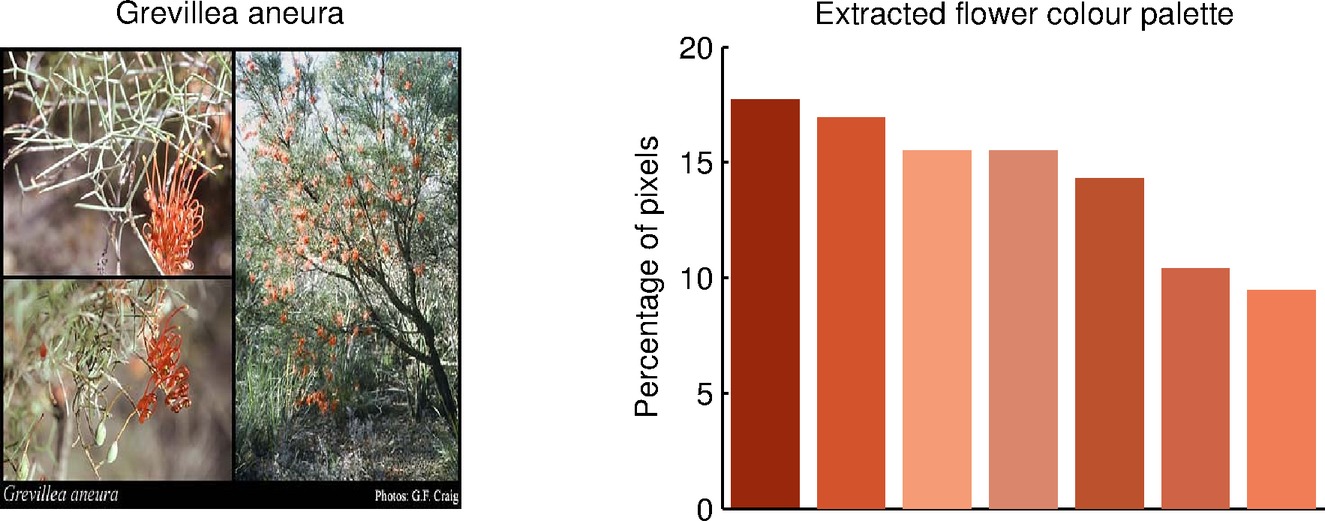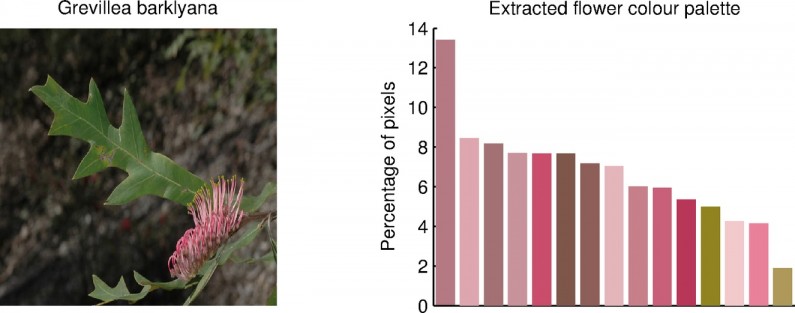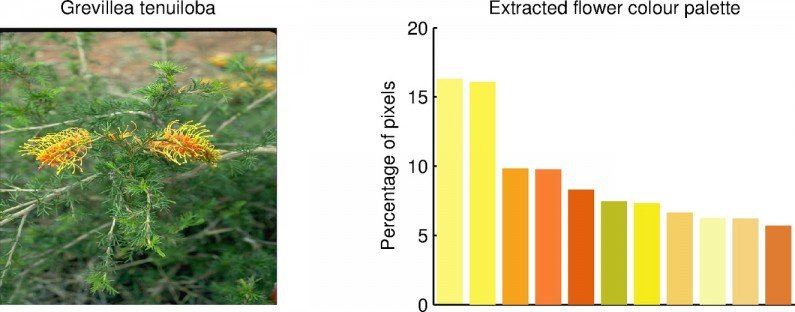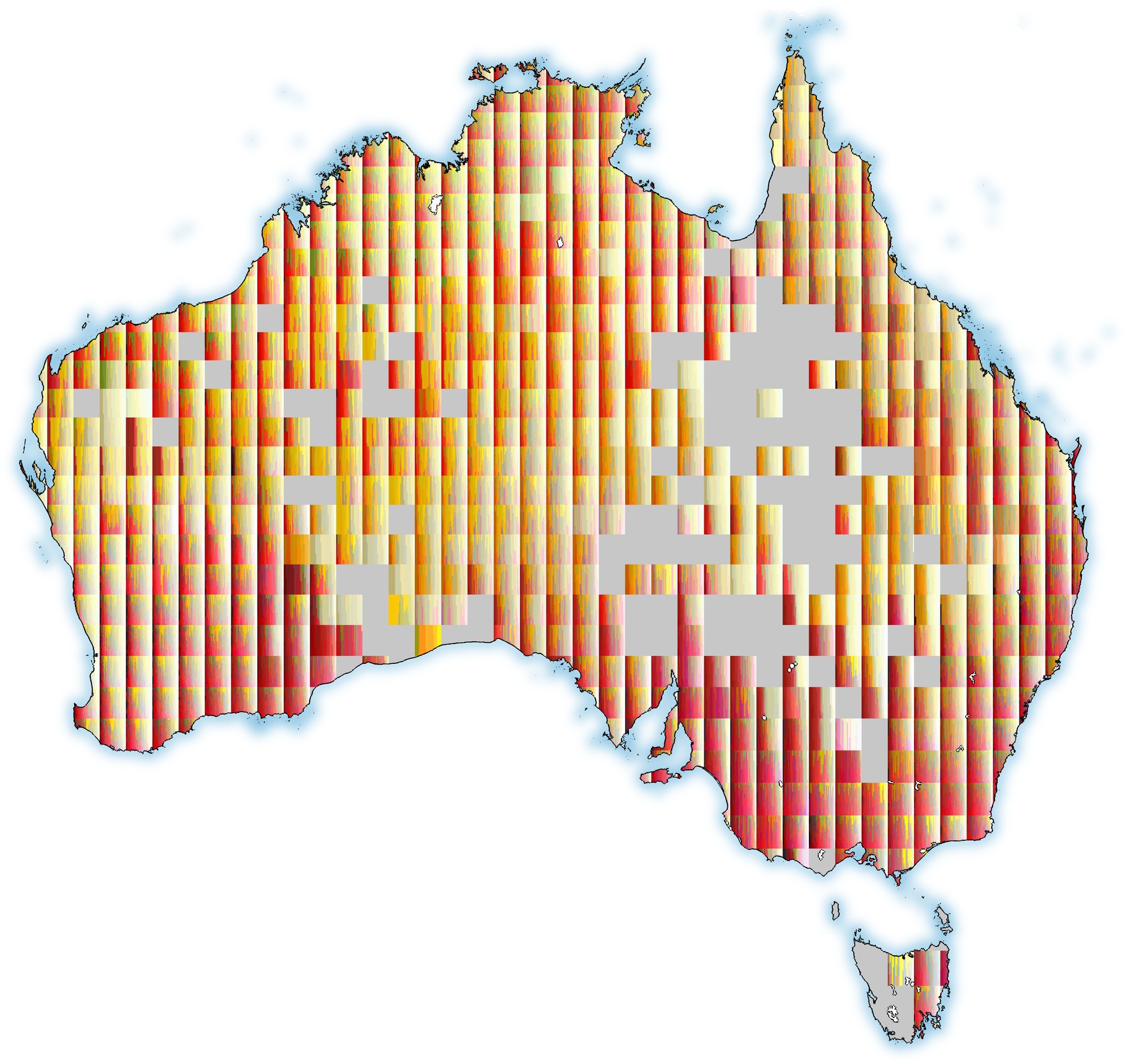Ben Raymond, scienceuntangled.com and R.O. (Bob) Makinson, Royal Botanic Gardens & Domain Trust
Scientific analyses are usually driven by a research question: frame the question and then collect or find the data that will allow it to be answered. Sometimes, though, it can be useful to work in the other direction: given data, find some questions to answer. The Atlas of Living Australia provides a wealth of biodiversity data, including occurrences, species profiles, taxonomic and name information, and photographs. This diversity of data, readily accessible through the ALA’s open web services, provides a foundation for analyses and visualizations that otherwise would be much more difficult, and perhaps might not even be considered.
Grevilleas are members of the Proteaceae plant family (which also includes proteas, waratahs, and banksias) and are widespread across Australia. They are evergreen shrubs or trees with a diverse range of flower and leaf shapes. The aim of this analysis was to visualize the spatial variation in Grevillea flower colour across Australia. This was done by first extracting species-specific flower colour information from photographs, and then linking this information to the locations of observations of those species.
Photograph processing
Species lists (taxon name and occurrence count) were extracted in each 1-degree square across Australia, using the Atlas of Living Australia’s occurrences web service (see http://biocache.ala.org.au/ws/). The ALA profile page for each species was also retrieved (e.g. Grevillea baxteri). These profile pages generally include a pointer to a photograph, which was downloaded and saved where available. Photographs were also retrieved from NSW Flora Online and the Australian National Botanic Gardens. The photograph that best depicted the flowers of a given species was chosen from those available.
The flowers (usually aggregated, in a conflorescence) in each photograph were manually delineated, and their colours tabulated. Some example photographs and their corresponding colour palettes are shown below.



Spatial reconstruction
The colour palettes were then linked back to the species lists in the 1-degree grid squares. A sample of colours in each grid cell was taken, keeping the relative proportion of colours true to the colour distribution within each species palette.
The resultant map is shown below. Grey indicates areas where Grevillea occurrence records were lacking, incomplete, or were for other reasons not used in the present analyses. Broad patterns in colour are apparent, with red colours most dominant in the southern parts of the continent.
Red- and orange-flowered species are typically pollinated by birds; yellow- and cream-coloured ones by insects, although there are exceptions to these general trends. This general latitudinal trend in Grevillea flower colour has been recognized by botanists for some time, although not formally published to our knowledge. However, it is worth noting that these analyses were entirely data-driven, and were not based on this existing knowledge.

Limitations
The sources of information used in this analysis were not exhaustive. Photographs were not available for all Grevillea species, and some were not suitable for extracting flower colours. The available photographs were also quite varied in terms of their resolution, lighting, and subject (with some specifically detailing the flowers; others the plant more generally). Survey effort, and therefore occurrence information, is also highly variable across Australia, particularly in remote areas. Additional occurrence data and imagery, for example from State herbaria and non-government sources, could provide a more comprehensive and detailed information base from which to work.
Future directions
For this initial run, palettes were based on overall flower/conflorescence colours. The colours of the styles and perianth were not differentiated. These within-flower contrasts may be important for pollinators, and may show their own spatial distribution patterns. The aggregation of palettes for multiple species within grid squares, and the non-differentiation of subgeneric groups (which sometimes correlate with insect- vs bird-pollination syndromes) may mask trends that remain available to more targeted future analyses.
Trends in the geographical patterning of flower colour could also be assessed and compared on the basis of subgeneric groupings within Grevillea. A full phylogeny of the genus is not yet available (but is in progress); in the meantime there are generally accepted morphologically-based groupings of species (Makinson, 2000). These include many potentially informative vicariant sister-sets (tropical/eremaean, tropical/temperate, western temperate/eastern temperate). The close sister genus Hakea, although not as speciose, is similarly widely distributed and also contains several infrageneric groups. Eventual analysis using both genera and their sub-groups, overlaid with known or inferred pollination syndromes, would improve resolution of spatial colour trends, allow significance testing by correlation, and allow some correction for over-dominance of some highly speciose and better known species-groups.
Trends in this tribe of Proteacece could then be assessed in relation to those in other plant families considered to be comparable in terms of distribution, colour variation, and quasi-correlated pollination modes. The tribe Melaleuceae (sensu Wilson et al. 2005) in the family Myrtaceae is one likely candidate.
The delineation of flowers within photographs was done manually in this instance and was a somewhat time-consuming process. Initial experiments with automated methods have shown promise, and are being developed further.
References
Makinson RO (2000) Proteaceae 2: Grevillea. Flora of Australia vol. 17A. ABRS, Canberra / CSIRO Publishing, Melbourne.
Wilson PG, O’Brien MM, Heslewood MM, Quinn CJ (2005) Relationships within Myrtaceae sensu lato based on a matK phylogeny. Plant Systematics and Evolution 251:3–19.